At the start of last year I made 19 allotment resolutions for 2019 – the year didn’t go according to plan (hence my failure to post any updates since March!) but wasn’t a complete failure. Before I post my plans for 2020 I thought I should revisit my resolutions from 12 months ago and see how many (if any) I managed to achieve.
So here they are with my current comments interspersed:
- Reclaim and reconstruct my Polytunnel – had great plans for this winter but would be happy to get it back in place in time for Spring sowings etc
Ooh this is better than I hoped! I’m starting with one I can tick off as done! With help from plot neighbour Dave – well to be honest I just stood back & gave encouragement – the frame was fixed back in January, moved back to my plot and the cover refitted at Easter. And then refitted again a few days later after a Spring storm! But it was only in early July that I managed to get beds set up inside, filled with compost and tomatoes and peppers I’d grown from seeds planted out. I later added aubergine, cucumber and tomatillo plants that I’d had to buy in after my seedlings failed – long before they got to the tunnel. From an empty shell almost overnight it turned into a veritable jungle – and I had successful crops of tomatoes, cucumbers and tomatillos. We’ll gloss over the failure of the peppers and aubergines
- Continue to develop and fill my lasagna beds so ready to plant in Spring.
A half tick on this one – one of the difficulties was finding enough material to add to the beds. I do save all of my kitchen waste (usually via a bokashi bin) & have also added leaves and weeds/old plants but still needed to top up with bought in compost -at a price. So filled a 3-4 this way and gave me some crops but still have another few that are still empty.
- Complete layout of paths with addition of wood chips and add more chippings to existing paths
Back in March I was making good progress with this as there were quantities of wood chips on site and I was taking several barrowloads each time I was there – but so were other folk so the pile soon diminished. Did cover some new areas but sourcing new supplies of wood chips (preferably for free!) is a current priority as my need has increased.
- Sort out seeds into monthly sowing order (today!) and resolve to keep tidy and organised throughout the year
A two part-pledge and I achieved the first part but have sadly failed on keeping them organised throughout the year. I ended up with seeds everywhere as moved them from home to shed to allotment etc. And finally a disaster when a leak in my polytunnel ruined about a dozen packets in an open container 😦
- Complete garden planner and check measurements etc as I finalise positions of beds and paths. Resolve to maintain the planner and update with any changes of locations of planting – I lost a few plants this year 😉 Use to plan second crops and intercropping.
Oh dear – more good intentions! Limited time and headspace – mainly as a result of the acquisition of Carrot (a dog not a pet vegetable!) have led me into haphazard plantings and not sticking to my plans. But even more problematic has not been recording accurately where I have planted out seedlings. Note to self – must do better!
- Resolve to accurately label seeds and plants – at all stages of the growing process. All brassicas look the same to me until they start to reach maturity!
Almost a tick for this one – I diligently labelled all seedlings and kept good control whilst they were in my shed and lean-to at home. But have had some problems on the plot – either because I’ve lost labels or because I seem to have failed to always use a permanent pen on my wooden labels.
- Reduce use of plastics
I do reuse all my pots and have also used old yoghurt pots etc. Also made some pots out of newspaper (they do dry out v quickly!). Still using wooden plant labels – cheapest ones I’ve found are sold as tongue depressors!
- Reduce costs by recycling as many materials as possible.
A big tick on this one. At times my plot has looked like a junkyard with all the foraged items I had accumulated from abandoned plots and also the school next door which is being refurbished. Still need to convert some items into usable structures. And I compost everything I can. Could do more perhaps to get compostable material from neighbours – they seem to give me some and then stop! Do acquire cardboard for mulching on a regular basis- can get some from a nearby shop but transport has been a little difficult lately. 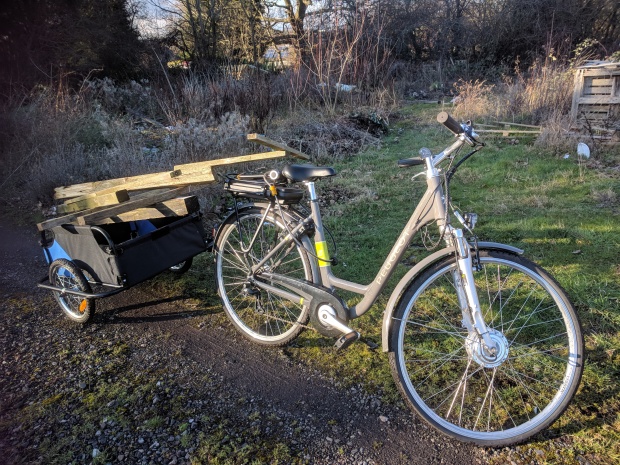
- Reduce long-term costs and workload by planting as many perennials as possible. Develop an area of food-forest on the plot and try to source as many plants from swaps and cuttings as possible.
A work in progress! In April I took on another half-plot next to mine and my intention was/is that I would treat this as my perennial food forest area and use my existing plot for the polytunnel, annuals etc. It all started well as the site had allegedly been cleared of brambles but I turned down the offer of rotavation as I strongly suspected there would be many roots of perennial weeds and brambles still in situ and rotavating would just spread them further. But before I could get the ground covered I took a decision that has had a major impact on my capacity to cope with my plots – at least in the short term. I adopted a rescued lurcher, who has been appropriately named Carrot, and hopefully in time will be an excellent allotment companion. But I had seriously underestimated how much input he would need in terms of training. For much of the summer I could neither leave him home alone nor can I get much done on the plot when he’s with me. And the result has been that the brambles are back! And so are many weeds including bindweed and docks. I am now having to arrange help and support to allow me to tackle these but its hard work and could have been avoidable if I had got ahead of myself with this new plot and could have spent some money on coverings.
- Save seeds from as many crops as possible – beans, peas, tomatoes etc Reduce the number of new seeds purchased so saving a few £££
I did sow some seeds that I had saved last year – with mixed results! A few tomatoes, but failures with a pepper and squash. Some germination but then failure as seedlings.
Have saved peas – Kent Blue and Roi des Conserves – from this years crop and also beans and tomatoes and tomatillos.
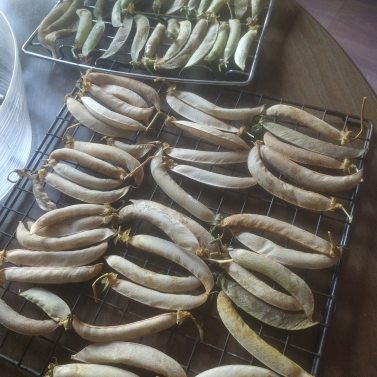
- Erect shed – make functional for storage of tools etc
Still awaiting construction of a base!!!! A priority for 2020
- Encourage more wildlife including pollinators, natural predators etc by growing flowering plants, companion plants, bug hotels, and a wildlife pond.
Do have some flowers – marigolds, nasturtiums, sunflowers, borage etc which are good insect attractors. No bug hotels yet. And my pond is in (slow!) progress! In return for not having half-plot rotavated I cheekily asked contractors on site if they could scoop out a pond for me – which they duly did. It has filled up with rainwater which doesn’t drain out due to the clay subsoil so I haven’t yet got around to reshaping and modelling it. And it is now surrounded by weeds and brambles.
- Use Garden journal regularly to keep track of what sown/planted etc
Have used my journal irregularly since Carrot came into my life – and the planner too. Am trying to get back on track.
- Record weight of harvested produce – to enable tracking and comparison in future years
Ha ha! Initially no harvests worthy of weighing. And now not organised enough to do so. Will look at how to start doing this – maybe with specific crops eg tomatoes, potatoes rather than every lettuce leaf.
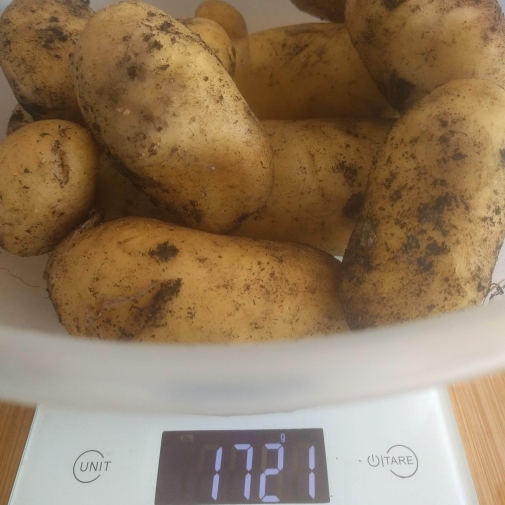
- Make home-made pesticides from soap etc and use regularly against pests
Did this one! Made a spray from soap & used it on blackfly on broad beans. Possibly helped although seemed to get a rust infection afterwards. Cinnamon to deter ants has not worked well so tried nematodes in polytunnel with mixed results.
- Sign up as a mother garden with Food Forest Brum and pledge to share cuttings of perennials I am trying together with surplus annual veg plants.
Not done this yet – still on back burner
- Volunteer regularly with Stirchley Fruit & Nut Village – to learn skills, contribute to planting trees and forest garden in area and make new friends.
Started off well with tree planting and a grafting workshop but arrival of Carrot hampered this one.
- Photograph plot and write regular blog articles about my allotment and other growing activities
Most I’ve managed are a few tweets and photos on instagram. Since Carrot arrived I’ve been under so much pressure just to do something when on the plot that I haven’t had time or capacity to take many photos. And its looked such a mess! Hopefully will start to improve in 2020!
- Take time to sit and enjoy the sound of the bees
I’ve barely noticed the bees – although the ants are another story! But as I start to get back on top of the overgrown areas hopefully will be able to find solace once more.
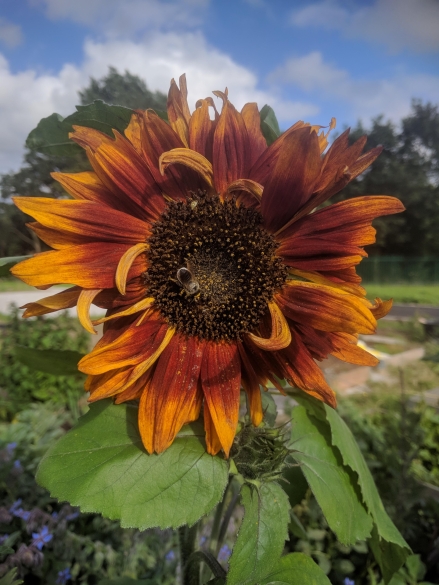
So a some successes – and a few failures or put on hold for now. What the above doesn’t mention is the impact of my role on the allotment committee during a year when the council were implementing major works including construction of a new road and installation of a clubhouse and storage sheds. It had a major impact both on the actual time it took but also on my stress levels and the sense of enjoyment I had on the site. Thankfully the work is now (allegedly!) complete and in 2020 I should be able to give more time to my own plots.










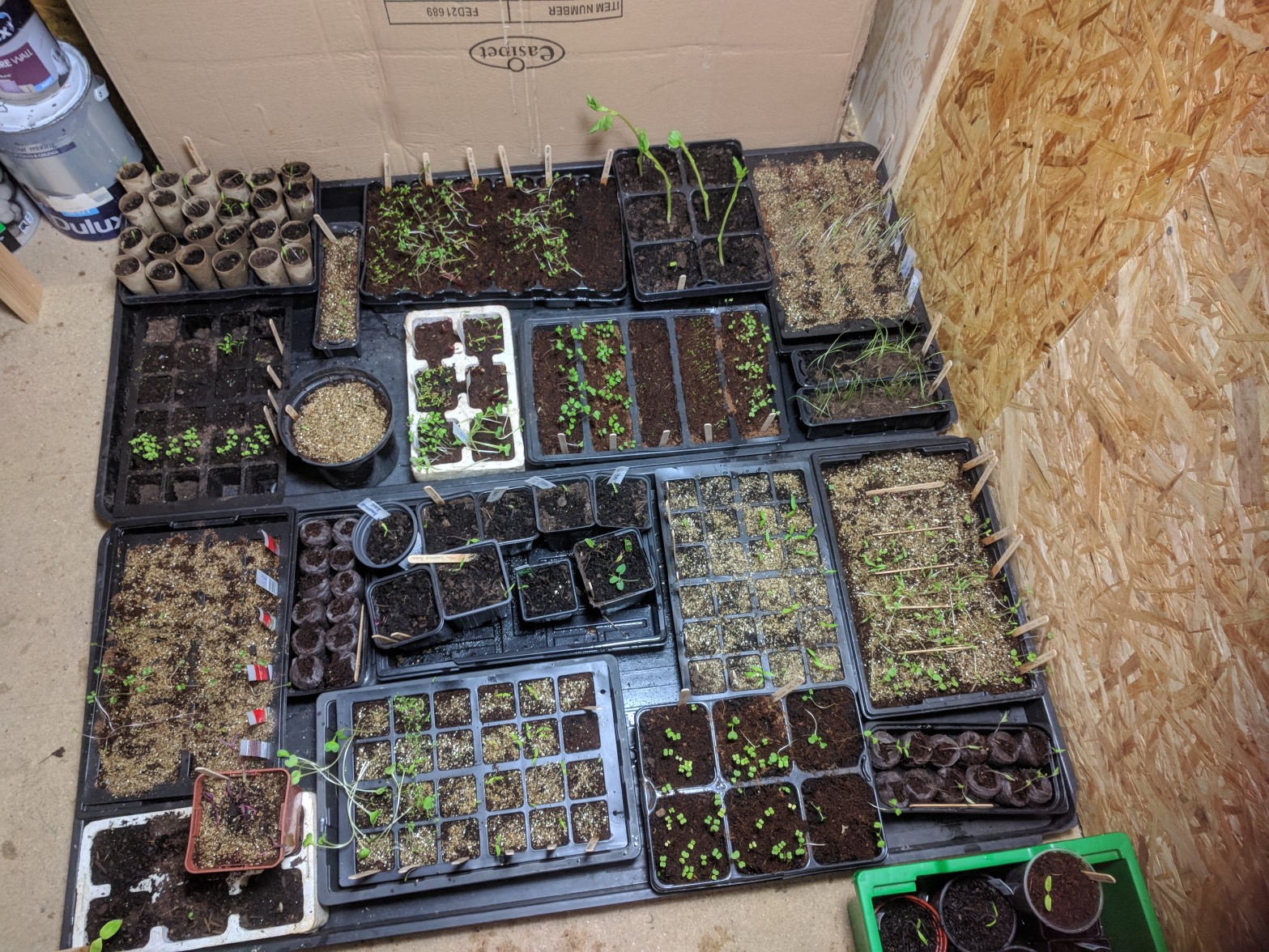
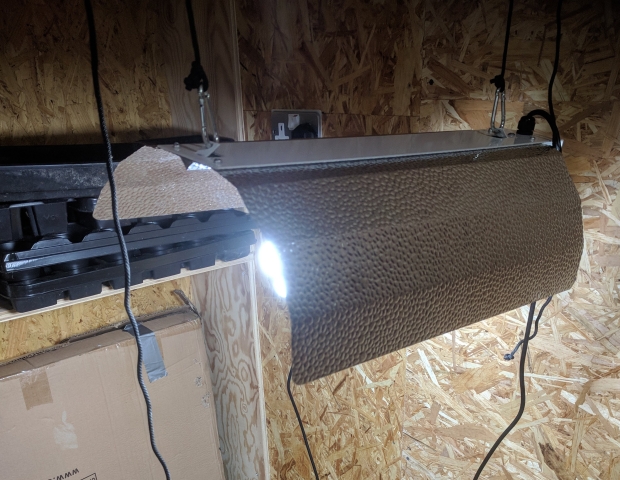
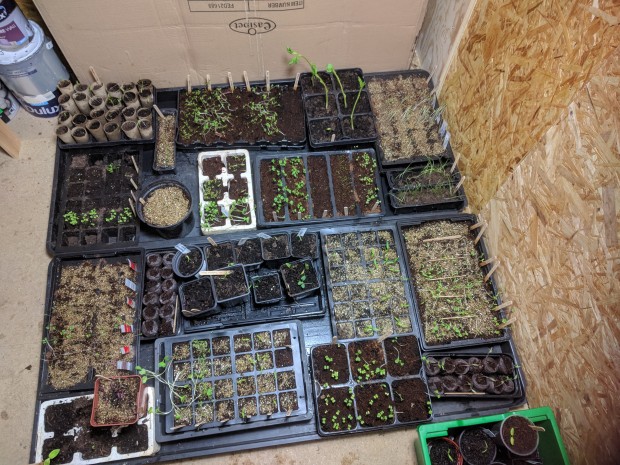
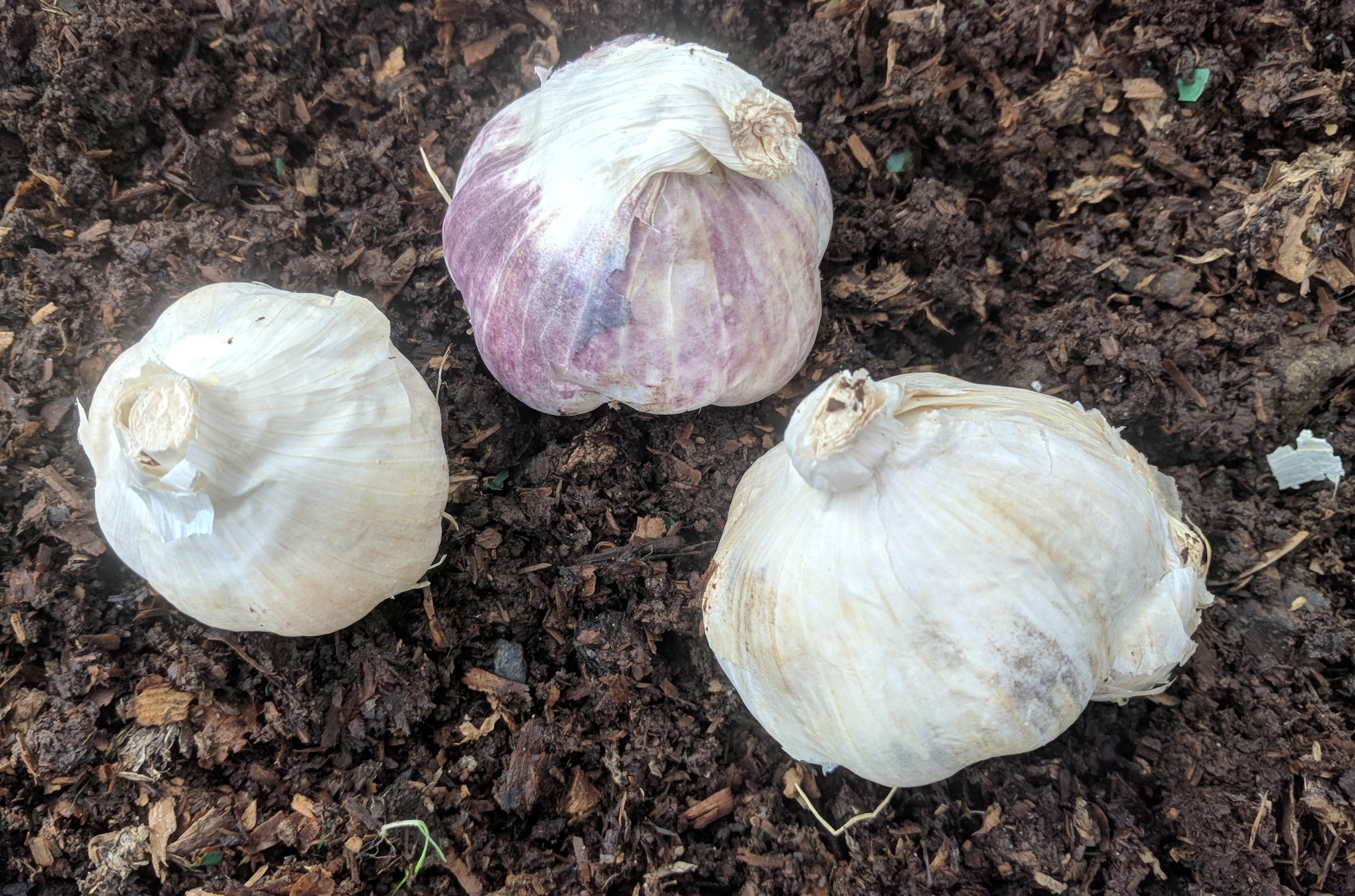














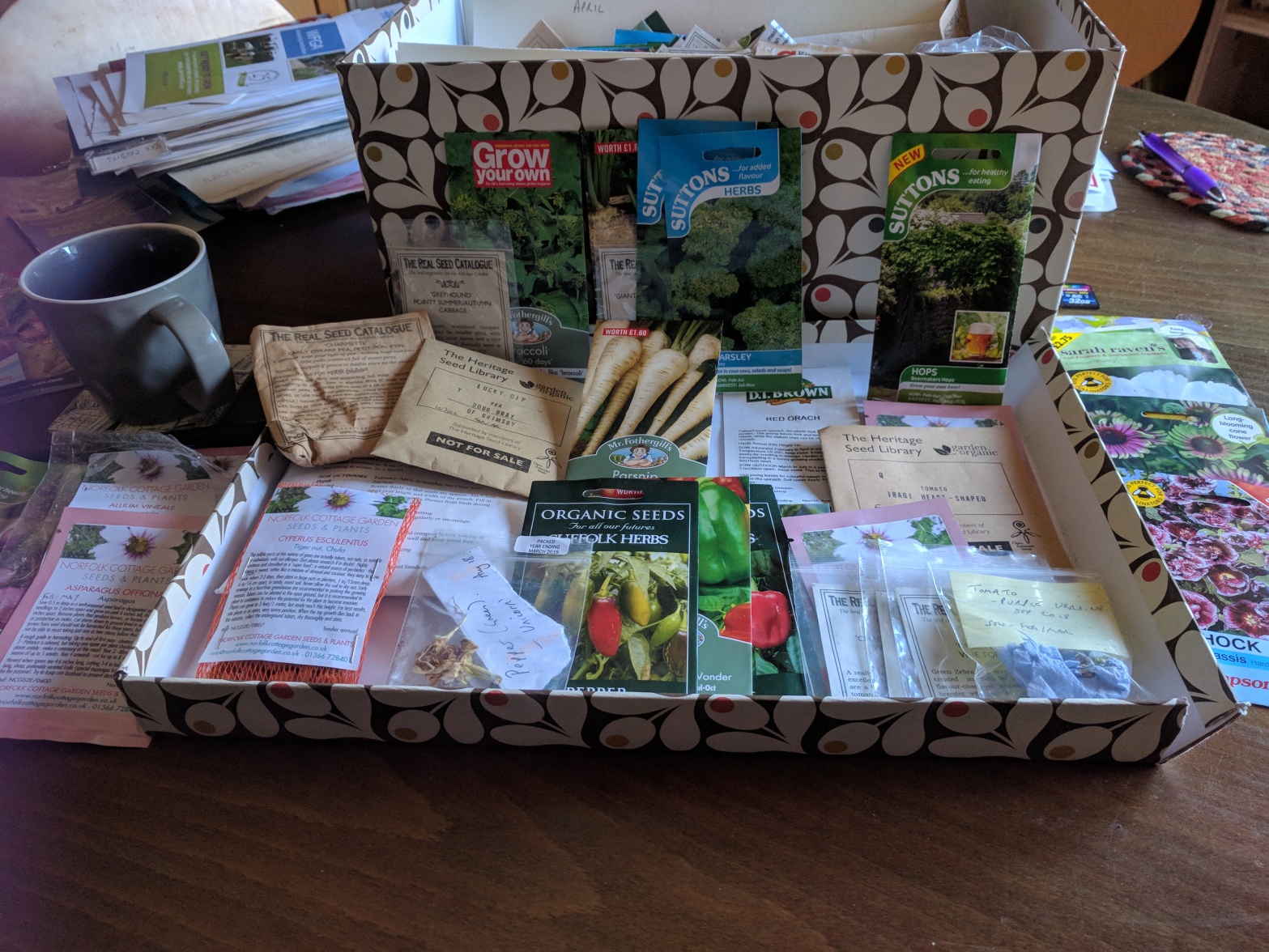
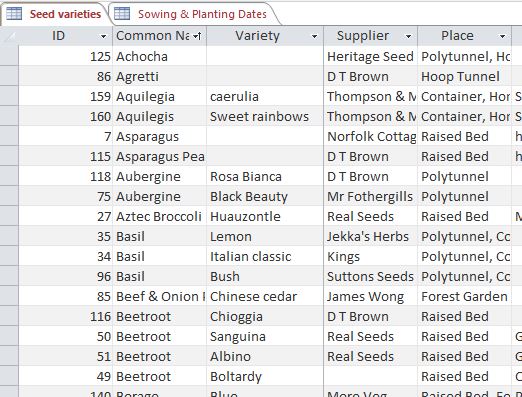
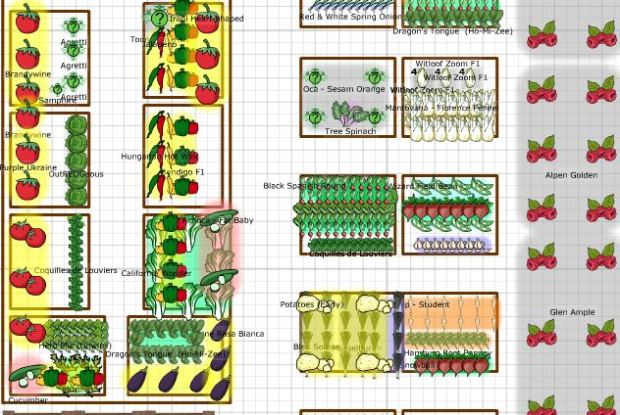







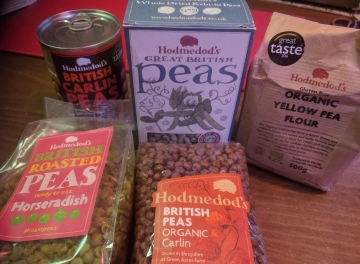


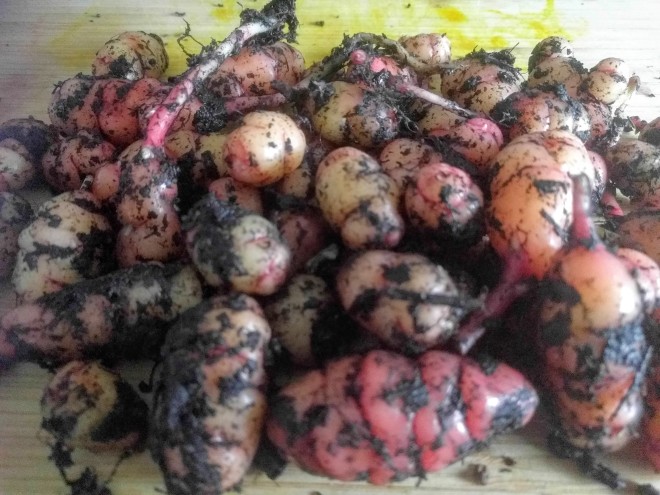


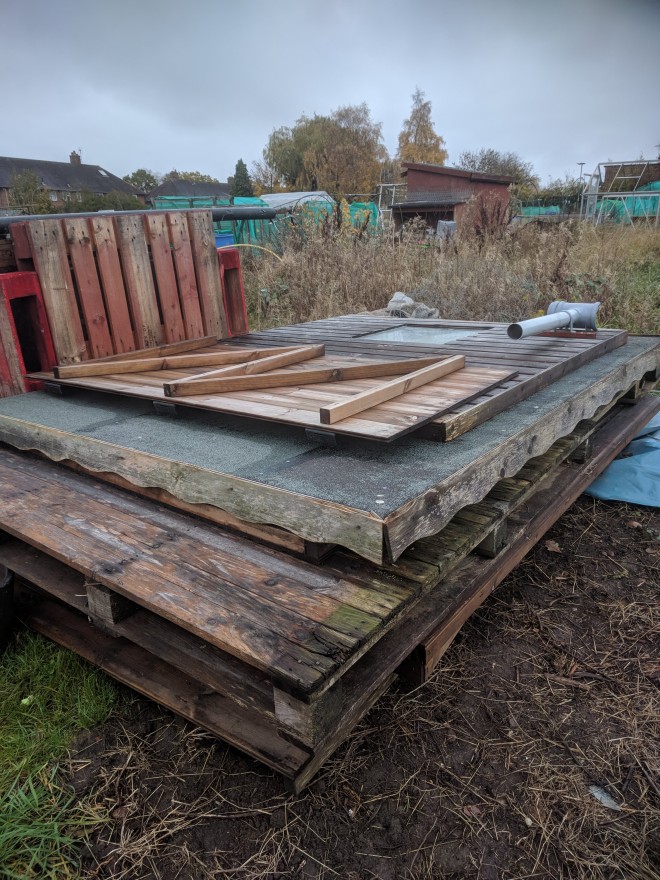
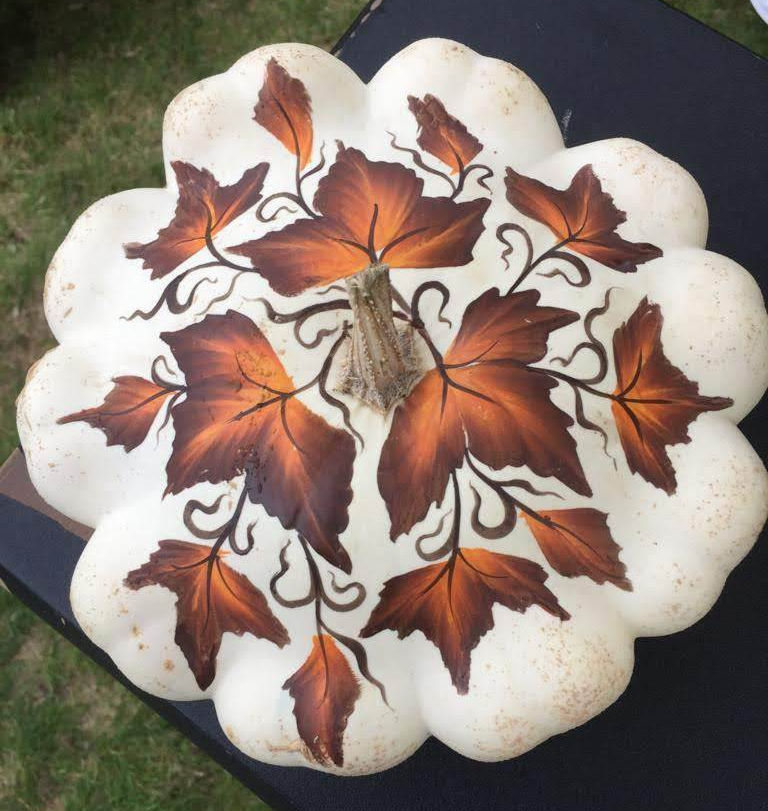
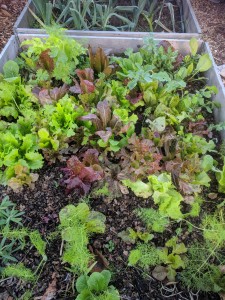 – taking a few leaves at a time from each plant. Throughout the summer I’d had no success at all despite several sowings but by September my last sowing had germinated and despite a slow start finally produced a decent crop and the plants are still going strong. This mix includes Reds, greens, brights, darks, splashes, blushes, crisps, butters, leafs, heads, and tongues. The mix is really attractive in a salad and all of them are tasty.I’m harvesting a bag full of leaves about once a week. Surprisingly they last really well in the fridge – much better than a commercial bag of salad despite them probably being in a protective atmosphere (at least until the bag is opened!).
– taking a few leaves at a time from each plant. Throughout the summer I’d had no success at all despite several sowings but by September my last sowing had germinated and despite a slow start finally produced a decent crop and the plants are still going strong. This mix includes Reds, greens, brights, darks, splashes, blushes, crisps, butters, leafs, heads, and tongues. The mix is really attractive in a salad and all of them are tasty.I’m harvesting a bag full of leaves about once a week. Surprisingly they last really well in the fridge – much better than a commercial bag of salad despite them probably being in a protective atmosphere (at least until the bag is opened!).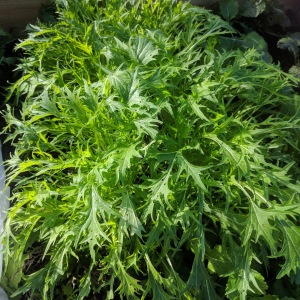 mizuna and with some mustard greens too. I was intending to make some successional sowings but haven’t gotten around to it (yet!) But if the mizuna keeps producing as well as it is at the moment maybe it’ll keep me going all winter….
mizuna and with some mustard greens too. I was intending to make some successional sowings but haven’t gotten around to it (yet!) But if the mizuna keeps producing as well as it is at the moment maybe it’ll keep me going all winter….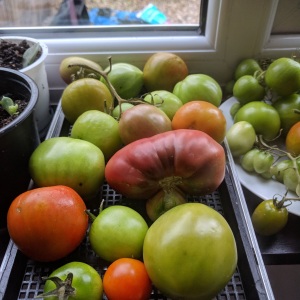 now although I do still have some from my garden ripening on the kitchen windowsill. I’m not a huge fan of chutneys (have to confess I prefer Branston pickle) so will wait for them to ripen gradually. I do fry some of them green and have with a breakfast fry-up.
now although I do still have some from my garden ripening on the kitchen windowsill. I’m not a huge fan of chutneys (have to confess I prefer Branston pickle) so will wait for them to ripen gradually. I do fry some of them green and have with a breakfast fry-up.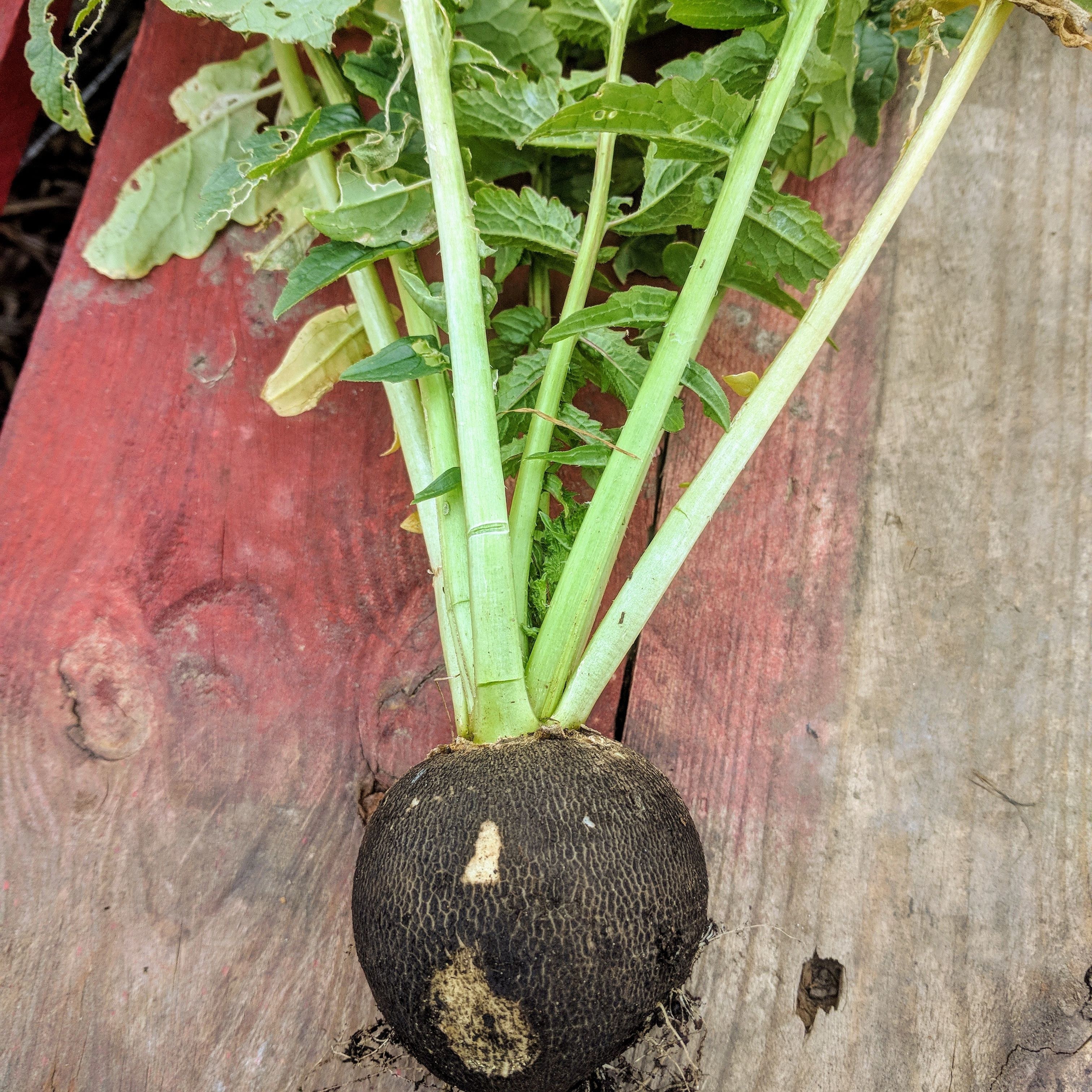 actually taste quite pleasant. So I’ve tried some Spanish black radish
actually taste quite pleasant. So I’ve tried some Spanish black radish

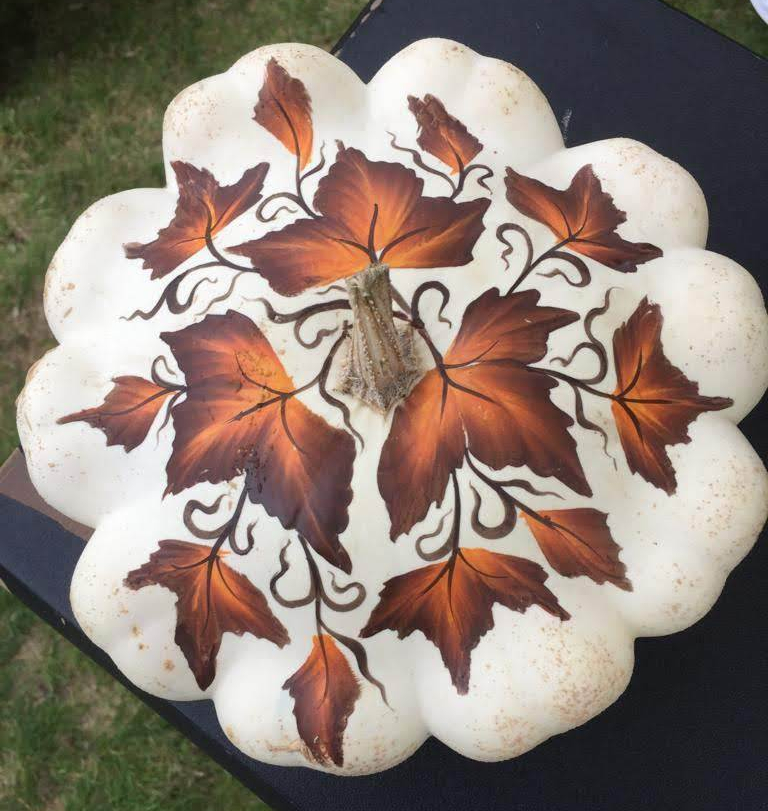
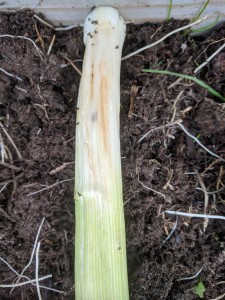 which have been infected by the dreaded allium leaf miner. The green leaves showed no signs so I was unaware of it until I harvested a couple of stems last week. So I’ve now harvested them all and disposed of any infected material. And so instead of a crop that I hope would keep me going over winter, I’ve been left with a few usable remnants that might just be enough to make me cup-of-soup! And of course, I am also a tad worried in case the bugs get onto my young garlic or onions. I’d planted elephant garlic in a gap in the leek bed but following the discovery of the ‘miners’ thought I should move them before they got too established. But furtling around in the soil to find them as they don’t have any green growth yet I was surprised to discover how much root growth they had put on. I didn’t feel I wanted to disturb them as they were doing well so decided to take a chance on leaving them in situ and will cover them with mesh to prevent any later infestations.
which have been infected by the dreaded allium leaf miner. The green leaves showed no signs so I was unaware of it until I harvested a couple of stems last week. So I’ve now harvested them all and disposed of any infected material. And so instead of a crop that I hope would keep me going over winter, I’ve been left with a few usable remnants that might just be enough to make me cup-of-soup! And of course, I am also a tad worried in case the bugs get onto my young garlic or onions. I’d planted elephant garlic in a gap in the leek bed but following the discovery of the ‘miners’ thought I should move them before they got too established. But furtling around in the soil to find them as they don’t have any green growth yet I was surprised to discover how much root growth they had put on. I didn’t feel I wanted to disturb them as they were doing well so decided to take a chance on leaving them in situ and will cover them with mesh to prevent any later infestations.